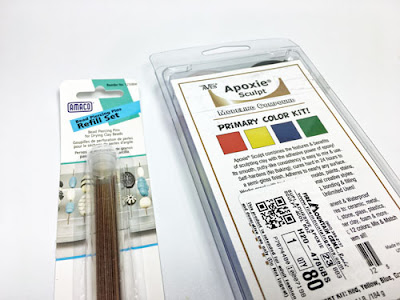I've said from time to time that there are somethings you can do to resin clay which is commonly applied to polymer clay. The advantage is resin clay does not need any baking as it cures by being left alone over 24 hours or so. The other thing about resin clay is its adhesive properties. There are also a couple of differences in the handling of resin clay compared to polymer clay which I will mention later in this tutorial on how to make candy swirl beads.
I generally only buy larger quantities of resin clay only in off white and black. As resin clay does has limited shelf life, buying smaller quantities of the strong colored clay makes sense. I used the red color of the
Apoxie Sculpt multi pack courtesy of Fire Mountain Gems. I also wanted to make beads with smaller holes suitable for beaders to mix and match with clay and beaded beads so they sent along
bead piercing pins.
 |
| Bead piercing pins and resin clay |
Resin clay is two part epoxy resin ( sort of the solid version of its liquid cousin). If you do not have weighing scales, then the easiest way to portion out 2 roughly equal amounts of Part A and B is to make similar size balls. The picture below shows how I used the two parts of the red color as well as two parts of my current supply of whitish clay.
Resin clay is not toxic (although as with anything, there may be some people who might be allergic). I wear the gloves not because I am allergic but because the clay can be really sticky when mixing the two parts together.
Once I mixed the white and the red colors, I took a portion of each mix and mixed again to get the pink color.
I then rolled out each color into long snakes.
Then the fun begins! I then randomly rolled the 3 rolls together. Note the powder you see on my hands come from the inside of the nitrile gloves I used. It didn't matter for the candy swirl idea I have but you might prefer to remove said powder before handling the clay!
I also twisted the combined roll in a random fashion, now and then.
I also doubled it up and re-rolled it. Anything to get a fun swirl pattern.
I tried to cut up even portions from the tubes so that the beads would be similar sized.
I tested out
the bead roller I had which polymer clay people use for making beads in 3 different shapes. It is a simple device with a groove and tongue bit on one side when both halves are fitted together.
Remember resin clay is sticky unlike polymer clay. So it took a few to and fro motions to get the clay to shape up. I usually grease up tools for resin clay. But in this case, do NOT use any oils. That would be too slick and you will not be able to make the beads.
Resin clay feels less cohesive than polymer clay so the edges of this shape was perhaps not as sharp. I used Burts Bee Hand Salve to coat the piercing pin so that the resin clay will not stick to it. You can also use a vegetable oil.
Then I randomly rolled each bead in some glitter.
I pressed some rondelles into the ends of some of the beads. As the clay is adhesive, the metal bits will stick.
I also made a larger bead without the roller. This is not as successful as the clay is heavier than polymer clay and had a tendency to lose it shape. So if you wish to make larger beads, use a wooden base (see the first link below for my previous tutorial on faux metal resin clay beads). Also note using a tooth pick to skewer the bead may distort. The piercing pin is finer, but you will have to work it to enlarge the hole especially if you
want to use grommets as shown below.
Once the beads are done, just let them cure overnight to 24 hours.
I used a liquid varnish (Varathane's diamond wood finish) to protect the beads.
And there you have it!
I used some of these beads mixed in with frosted beads for this simple necklace design!
PhotographyI used natural light, my iPhone 6S with the ProCamera app and the Modahaus TS400 tabletop studio for final product photography. The tutorial pictures were taken with the same equipment but with artificial lights in my windowless basement studio. Check out my
How to Photograph Jewelry Webinar .
DisclosureI do receive a small fee for any products purchased through affiliate links. This goes towards the support of this blog and to provide resource information to readers. The opinions expressed are solely my own. They would be the same whether or not I receive any compensation.
Before You Go:______________________________
Original Post by
THE BEADING GEMJewelry Making Tips -
Wire JewelryTips -
Jewelry Business Tips 